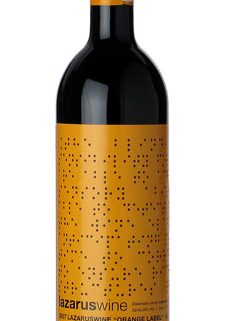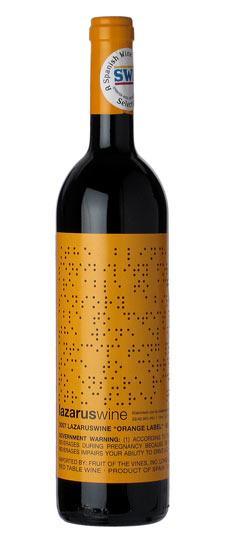Blind Winemakers and “Sensorial Winemaking”
In a world market where stories sell, LazarusWine has a unique story. The wine is good, but we’ll get to that later. What I’m most interested in is the label, and the winemakers that tell their story through this wine. For most of us, the visual prominence of the orange label is captivating. But what are those graphics about? Their not graphics? No – touch it – the label is in braille. Beauty and function. Why don’t more products do this?
The label reads “The blind, thanks to a high sensitivity of taste and smell, are able to achieve very precise sensory abilities. They are able to detect deviations during the wine elaboration process, anticipating potential problems, allowing time to correct them in order to ensure richer aromatics and structures reach the mouth.” (double translated, braille to Spanish to English)
That leads to the second point of interest. Most of the winemakers are blind. When one sense is missing, the others make up for it. LazarusWine calls this “sensorial winemaking.” The concept came from the observations of Antonio Tomás Palacios, a Professor of Enology at the University of La Rioja, as he observed a blind colleague was able to detect subtle changes to the wines long before the experienced sighted winemakers.
In 2002, Palacios teamed up with Bodegas Edra in the Ribera del Gallego to create a training ground for educating blind winemakers in sensorial winemaking methods. With an enhanced experience of taste and smell, the winemakers are able to detect and respond to potential flaws and opportunities for flavor development. The consumer benefits from their expertise.
My review of LazarusWine “Orange Label”, Red Wine, Spain
The Orange Label wine from LazarusWine is a 50/50 blend of Syrah and Merlot. Though French in origin, these grapes have found a happy home in the northern part of Spain, just beyond the border.
This wine is deep violet in color with aromas of plum and blackberry. It has flinty black pepper notes and a hint of meatiness from the Syrah. On the palate, the tannins are still quite tight – some time in a decanter or swirling in the glass will ease this. There is a good backbone of acidity behind the juicy plum-berry flavors that draw to a mineral close.
The wine may be from Spain, but with the French roots, I don’t feel bad recommending a hearty boeuf bourguignon or roast leg of lamb with Provencal herbs. Paella is also a great choice.
I enjoyed this wine very much. It should age well for at least 5 years, and it might be fun to taste it again then. If you do drink it now, I highly recommend decanting for a couple hours before serving, and serve slightly below traditional American room temperature. Despite its notoriety, this wine may be difficult to find. It’s currently available online for $26.99/bottle from Despaña in NYC.
- Easy Oven Roasted Turkey Breast Roll Recipe with Wild Mushrooms and Kale - December 1, 2023
- A Sexy Hot Sorrel Drink Recipe with Caribbean Rum - November 30, 2023
- Charcuterie Board for Two: how to build a date night charcuterie board - November 10, 2023
Did you know that eating the right foods can be the key to boost your sex life?
Subscribe to the Eat Something Sexy mailing list for tips on eating for romance and sex and get our exclusive list of Six Great Sex-Boosting Snack Foods for FREE!






Leave a Reply
Want to join the discussion?Feel free to contribute!